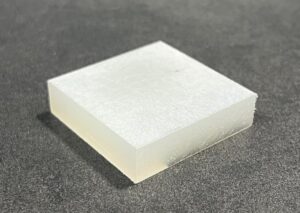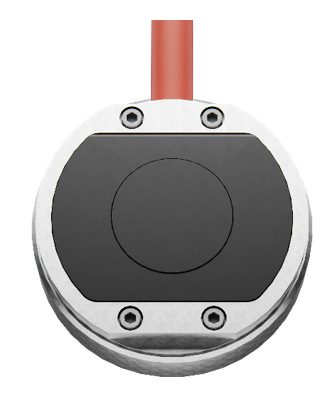In this application, we will be investigating the thermophysical properties to understand the thermal conductivity of Polypropylene.
Polypropylene is one of the most wildly used plastics in manufacturing today. Known for its low density (lowest compared to all thermoplastics), resistance to stress and chemical resistance, this thermoplastic is used across various industries. Applications include packaging, medical devices, clothing and fabrics, car parts, toys, and furniture. Polypropylene also has high electric resistance, making this plastic a great insulator for electrical components. This synthetic resin is widely accessible and cost-effective giving it a higher advantage over other commercial thermoplastics.
The applications of polypropylene are seemingly endless with a wide range of utility in a variety of industries. While its mechanical properties are well understood, thermal conductivity remains rarely addressed. In this application, we will be measuring the thermal conductivity (W/m·K), thermal diffusivity (mm²/s), and volumetric specific heat (MJ/m³K) of polypropylene in the asymmetric configuration.
A single sample of polypropylene was measured for thermal conductivity (W/m·K), thermal diffusivity (mm2/s), and volumetric specific heat (MJ/m3K) using the Measurement Platform Versatile (MP-V) with Modified Transient Plane Source (MTPS) sensor. The MP-V with MTPS method is used to measure the absolute thermophysical properties of isotropic, anisotropic and slab materials in the asymmetric configuration.
Polypropylene is classified as a tough, crystalline thermoplastic. Polypropylene is among the lightest of polymers, with low density and high heat resistance. Depending on how the product is formed polypropylene can be hard or soft, opaque or transparent, light or heavy, and insulative or conductive. Due to this versatility, polypropylene has wide application in a variety of industries including food packaging, medical supplies, furniture, automotive parts, and plastic films.
One of the major advantages of this polymer is it has the potential to be thermally conductive or insulative. In its natural state, polypropylene is strongly insulative. However, when this polymer is combined with a filler, such as talc or calcium carbonate, the thermal conductivity increases substantially. This synthetic resin is also a fully recyclable material, making it an attractive alternative to other plastics. It is clear why polypropylene is among the most used types of plastic in manufacturing today.

Figure 1. Polypropylene sample
The MP-V is designed to test the absolute thermal conductivity, thermal diffusivity, specific heat and thermal effusivity of solids, liquids, pastes and powders. The MP-V features a powerful combination of the transient plane source (TPS, ISO 22007-2) and transient hot-wire (THW, ASTM D7896-19) methods with a variety of sensors that are compatible with it.
Transient methods share similar theories with differences that are specific to their primary design. The sensors are electrically connected to a power supply and sensing circuit. A current passes through the sensors and creates an increase in temperature, which is recorded over time. The heat generated is then diffused into the sample at a rate dependent on the thermal transport characteristics of the material.
The MP-V features the proprietary intelligent Transient Plane Source (iTransient) function that is designed for the automation of testing and analysis. iTransient requires only the sample name as user input and the appropriate sensor and test parameters for each individual sample are determined.
The Modified Transient Plane Source Sensor (MTPS) is comprised of a TPS sensor configured with known backing insulation, permanently housed in a rugged single-sided configuration. This unique design combines the intelligent design of the sensor and measurement capabilities to generate bulk and directional properties for all materials. This sensor is capable of absolute testing anisotropic, slab and one-dimensional samples.

Figure 2. MTPS sensor.
A single piece of polypropylene was measured in the asymmetric configuration using an absolute MTPS sensor. Optimal parameters of 80s and 0.030 W were determined using the proprietary iTransient application to achieve appropriate temperature rise and accurate, repeatable results. Using the extended sensor correction, the contact resistance between the sensor and the sample was measured and automatically removed to ensure the best analysis possible is used for calculation.
Table 1. Thermophysical measurements of Polypropylene.
| Temperature (°C) | Thermal Conductivity W/(m⋅K) | Thermal Diffusivity mm²/s | Volumetric Heat Capacity MJ/(m³K) |
| 26 | 0.270 | 0.172 | 1.570 |
| 0.280 | 0.181 | 1.544 | |
| 0.282 | 0.183 | 1.547 | |
| 0.286 | 0.190 | 1.510 | |
| 0.283 | 0.187 | 1.510 | |
| Mean (W/m·K) | 0.280 | 0.183 | 1.536 |
| Standard Deviation | 0.006 | 0.007 | 0.026 |
| %RSD | 2.3 | 3.8 | 1.7 |
Polypropylene, 12.8 mm radius (MTPS), 80s, 0.030 W, 26°C, n=5.
Polypropylene is widely used in many different industrial applications where low density, high resistance to heat and high electric resistance are required. In this application, we investigated the thermal properties of polypropylene and found that it was highly insulative with a thermal conductivity of 0.28 W/m·K. Measured with accuracy and repeatability with the MTPS sensor. The thermal conductivity of polypropylene measured with MTPS was found to be in good accordance with the literature value range, 0.1-0.3 W/m·K at 20°C.
Dogan, F., Wang, W., & Zeng, Y. (2020). Polypropylene: Polymerization and characterization of mechanical and thermal properties. IntechOpen.
Maier, C., & Calafut, T. (1998). Polypropylene: The definitive user’s guide and databook. Plastics Design Library.